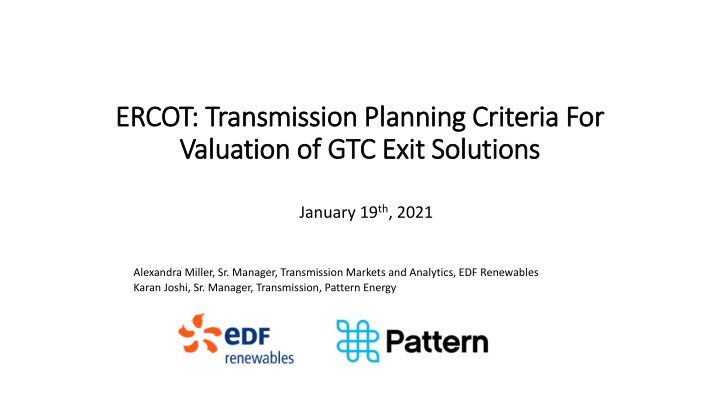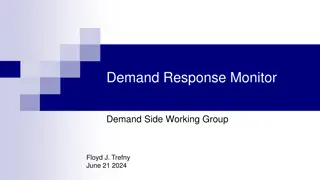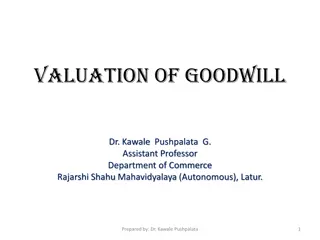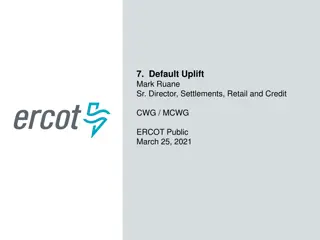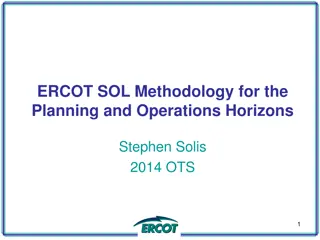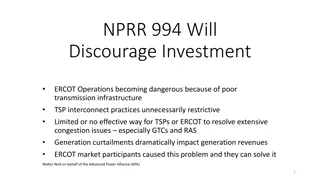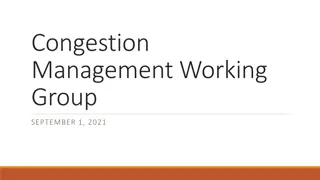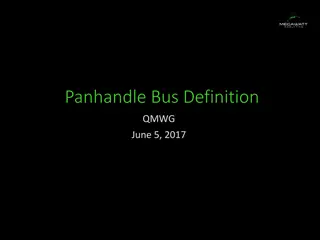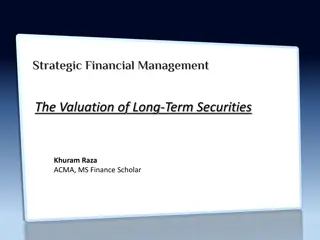Enhanced Criteria for Valuation of GTC Exit Solutions in ERCOT Transmission Planning
GTC exit solutions in ERCOT are crucial for addressing stability issues. This report suggests improvements in evaluation criteria and modeling changes to enhance the accuracy of assessing GTC exit solutions. Key concepts include utilizing market data for bid prices, modeling transmission outages impact, and factoring in operational limits and cost savings. These enhancements aim to widen the benefits and improve assessment accuracy.
Download Presentation

Please find below an Image/Link to download the presentation.
The content on the website is provided AS IS for your information and personal use only. It may not be sold, licensed, or shared on other websites without obtaining consent from the author.If you encounter any issues during the download, it is possible that the publisher has removed the file from their server.
You are allowed to download the files provided on this website for personal or commercial use, subject to the condition that they are used lawfully. All files are the property of their respective owners.
The content on the website is provided AS IS for your information and personal use only. It may not be sold, licensed, or shared on other websites without obtaining consent from the author.
E N D
Presentation Transcript
ERCOT: Transmission Planning Criteria For ERCOT: Transmission Planning Criteria For Valuation of GTC Exit Solutions Valuation of GTC Exit Solutions January 19th, 2021 Alexandra Miller, Sr. Manager, Transmission Markets and Analytics, EDF Renewables Karan Joshi, Sr. Manager, Transmission, Pattern Energy
Executive Summary GTCs are pseudo-thermal limitations used to control stability problems GTC exit solutions can have additional benefits beyond production cost savings since they solve system-wide stability problems PUCT already allows for indirect benefits to be included in cost benefit analysis There are evaluation criteria and modeling changes ERCOT should evaluate for implementation to improve accuracy of GTC exit solution assessments There is ground for ERCOT to widen the benefits for evaluating GTC exit solutions this can be enabled by additional language in the Nodal Protocols After incorporating stakeholder feedback, surveying suggested and implemented measures across RTO s, and considering impact and ease of implementation, five key concepts were selected for improving the criteria: three modeling improvements, two indirect benefits
GTC Exit Solutions Proposed Criteria and Modeling Changes 1. Utilize proxy bids derived from actual market data, rather than default marginal fuel cost ($0/MWh) for renewables in all planning models to properly reflect negative LMP 2. Model the impact of transmission outages both on the system topology and the impact to GTLs 3. Planning models must reflect the most likely Operational limits including the derates for IROL or other safety margins rather than the 100% GTL as defined 4. Account for the cost savings of transmission reliability projects that will be deferred or avoided by a GTC exit solution 5. Include the impact to reserve margin, and therefore Expected Unserved Energy (EUE), due to suppression of generation by GTC s | 3 January 2021 PLWG, GTC Exit Solutions in Transmission Planning
1. Model correct bid price In order to accurately capture the congestion rent and which specific constraints are most likely to happen in market operations, a more realistic reflection of actual bid price must be included in models Actual historic bid prices for operating projects are readily available Future projects can be assumed to bid at prices reflecting PTC based on COD Note in the West Zone, up to 13% of Wind does not bid negative while 87% of it bids highly negative, creating key differences in which generators are likely to curtail and resulting flows Wind ERCOT West Zone ERCOT South Zone ERCOT North Zone ERCOT Houston Zone Wtd Average* -$24.00 -$24.21 -$28.36 -$31.70 % < $0 87% 93% 90% 100% MW 20,255 6,558 1,340 151 Solar ERCOT West Zone ERCOT South Zone ERCOT North Zone ERCOT Houston Zone -$2.80 -$0.51 - -$0.29 58% 80% - 100% 3,613 315 - 120 *Source: ERCOT 61-day Generation Resource data in SCED (QSE) for Oct 1, 2020 | 4 January 2021 PLWG, GTC Exit Solutions in Transmission Planning
2 & 3. Model Realistic Limits GTC limits that are IROLs are often lower than limits that are utilized in Planning Models: having a higher limit in Planning Model causes the results from planning studies to diverge from how the system is operated in DAM and RT During outage conditions which are common and inevitable, the limits are further reduced Both considerations must be reflected in Planning models Panhandle example shows much lower limits are experienced in reality than the official GTL | 5 January 2021 PLWG, GTC Exit Solutions in Transmission Planning
2 & 3. Model Realistic Limits Reflecting required operational IROL margin is straightforward Also consider any expected system changes such as additional generation build that will likely lower limits Options for reflecting impact of grid outages on limits ideally model outages impacting flows and the resulting derates on GTLs Multiple years of historic outage patterns by voltage level Define typical expected future outage pattern or probabilistic solution If not modeling outages explicitly in case, at a minimum use average seasonal derate of GTL based on historical limits for older GTC s and apply to similar newer GTC s based on number and voltage level of prior outage lines in definitions - Complex GTC s with many lines and prior outage impacts will be more heavily impacted | 6 January 2021 PLWG, GTC Exit Solutions in Transmission Planning
4. Avoided Reliability Project Cost Include in benefits the costs of any investments not needed due to the implementation of the GTC exit strategy including avoided costs of shunt devices deferred reliability projects or upgrades ERCOT is doing this already, however, there is limited documentation around how the evaluation is being done The length of the assessment can be critical - include signals from LTSA and System Needs and Constraints Report to capture reliability upgrades needed to serve major load centers on the longer term that may be avoided | 7 January 2021 PLWG, GTC Exit Solutions in Transmission Planning
5. Reduced Reserve Margin The long-term impact of GTC s on development locations is uncertain but is expected to be negative and more severe in regions with GTCs that separate the best resource areas from the higher demand areas At a minimum, the short and medium-term impact to operating projects and projects currently meeting planning criteria must be reflected in models The combined impact of all GTC s simultaneously will have a bigger effect on Expected Unserved Energy than when considered separately, as the relationship between reserve margin and EUE is non-linear (see graph) Leverage the Reserve Margin Study by Astrap to evaluate the increased risk of reliability events due to GTC-constrained generation Source: 2020 EORM Study SAWG Presentation 10/26/2020 | 8 January 2021 PLWG, GTC Exit Solutions in Transmission Planning
5. Reduced Reserve Margin Steps: Consider the total impact of all active GTC s with correct operational limits and typical outage derates Determine impact on reserve margin due to curtailed generation as the difference in the case with all GTC s active and a case with no GTC s Use Reserve margin Study results to determine expected increase in Firm Load Shedding due to all GTC s Allocate total increase in cost of EUE (at Value of Lost Load of $9,000/MWh) to each GTC by their individual contribution to curtailment | 9 January 2021 PLWG, GTC Exit Solutions in Transmission Planning
Next Steps: Consolidate feedback after today's presentation EDFR/Pattern to submit NPRR reflecting proposed changes including: Make language changes to the Nodal Protocols Section 3.11.2: Transmission Planning/Planning Criteria - Add clarification of realistic bid price assumptions to 3.11.2.5 - Add a new sub-section 3.11.2.7 to Planning Criteria for evaluation of Exit Strategies for GTCs including: - Appropriate accounting for impact of transmission outages - Planning models reflecting operational limits and reductions for IROL factor of safety - Cost savings of reliability projects that can be avoided - Impact to EUE due to system-wide curtailed generation | 10 January 2021 PLWG, GTC Exit Solutions in Transmission Planning
3.11.2 Planning Criteria (1) ERCOT and TSPs shall evaluate the need for transmission system improvements and shall evaluate the relative value of alternative improvements based on established technical and economic criteria. (2) The technical reliability criteria are established by the Planning Guide, Operating Guides, and the North American Electric Reliability Corporation (NERC) Reliability Standards. ERCOT and TSPs shall strongly endeavor to meet these criteria, identify current and future violations thereof and initiate solutions necessary to ensure continual compliance. (3) ERCOT shall attempt to meet these reliability criteria as economically as possible and shall actively identify economic projects to meet this goal. (4) For economic projects, the net economic benefit of a proposed project, or set of projects, will be assessed over the project s life based on the net societal benefit that is reasonably expected to accrue from the project. The project will be recommended if it is reasonably expected to result in positive net societal benefits. (5) To determine the societal benefit of a proposed project, the revenue requirement of the capital cost of the project is compared to the expected savings in system production costs resulting from the project over the expected life of the project. Indirect benefits and costs associated with the project should be considered as well, where appropriate. The current set of financial assumptions upon which the revenue requirement calculations is based will be reviewed annually, updated as necessary by ERCOT, and posted on the Market Information System (MIS) Secure Area. The expected production costs are based on a chronological simulation of the security-constrained unit commitment and economic SECTION 3: MANAGEMENT ACTIVITIES FOR THE ERCOT SYSTEM ERCOT NODAL PROTOCOLS APRIL 11, 2018 3-111 PUBLIC dispatch of the generators connected to the ERCOT Transmission Grid to serve the expected ERCOT System Load over the planning horizon. This market simulation is intended to provide a reasonable representation of how the ERCOT System is expected to be operated over the simulated time period. The market simulation shall reflect a realistic expectation of bid prices for all generation resource types, including negative bidding due to Production Tax Credits (PTC). From a practical standpoint, it is not feasible to perform this production cost simulation for the entire 30 to 40 year expected life of the project. Therefore, the production costs are projected over the period for which a simulation is feasible and a qualitative assessment is made of whether the factors driving the production cost savings due to the project can reasonably be expected to continue. If so, the levelized ERCOT-wide annual production cost savings over the period for which the simulation is feasible is calculated and compared to the first year annual revenue requirement of the transmission project. If this production cost savings equals or exceeds this annual revenue requirement for the project, the project is economic from a societal perspective and will be recommended. I can t find a better place to add this, which needs to be in all planning models, not just for GTC. The section on planning model doesn t go into this level of detail on assumptions. This may not need to be specified as a best practice, but does need to be brought to their attention. | 11 January 2021 PLWG, GTC Exit Solutions in Transmission Planning
3.11.2 Planning Criteria (contd) (6) Other indicators based on analyses of ERCOT System operations may be considered as appropriate in the determination of benefits. In order for such an alternate indicator to be considered, the costs must be reasonably expected to be on-going and be adequately quantifiable and unavoidable given the physical limitation of the transmission system. These alternate indicators include: (a) Reliability Unit Commitment (RUC) Settlement for unit operations; (b) Visible ERCOT market indicators such as clearing prices of Congestion Revenue Rights (CRRs); and (c) Actual Locational Marginal Prices (LMPs) and observed congestion. (7) When evaluating Exit Strategies for Generic Transmission Constraints (GTC) additional considerations impacting the ERCOT system shall be reflected in determination of benefits: (a) The impact of transmission outages on the GTC limit due to outages of elements included in the definition shall be reflected in the production cost simulation. Production Cost estimates with the GTC in place shall include a representation of typical outage timing and durations based on history and future expectations. The historical outage frequency and duration of all prior outage lines (or similar lines for new ones without historical reference) shall be considered in creating a reasonable expected case for simulations. (b) Future expected operational margins for GTLs shall be used in planning models. The limits for GTCs modelled in planning cases shall reflect the most likely future operational limit, including discounts for SOL and IROL required margins or other likely reductions. In the absence of specific planned system improvements that would increase a GTC limit in the planning horizon, the appropriate 10- 15% discount shall be applied to the GTL as it is in operations. (c) Benefits shall include the avoided cost of reliability projects that would be needed in the absence of a proposed exit strategy. (d) The impact to system reserve margin shall be computed by modelling all GTC s on the system and determining the simultaneous total impact of GTC s on EUE due to constrained generation. The cumulative impact across the system of local restrictions on generation is non-linear. When all the system wide GTC s are considered together, the total potential reduction in capacity available to serve the system load is more significant than if each were in effect alone. Determine the total capacity reduction across all generation types due to all expected GTC curtailment and use annual reserve margin study estimates of increase in EUE for that total loss of available capacity. Distribute the value ($9000/MWh * total lost load change) attributable to each GTC by their contribution to the total capacity reduction. | 12 January 2021 PLWG, GTC Exit Solutions in Transmission Planning
